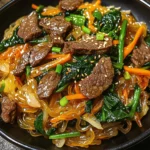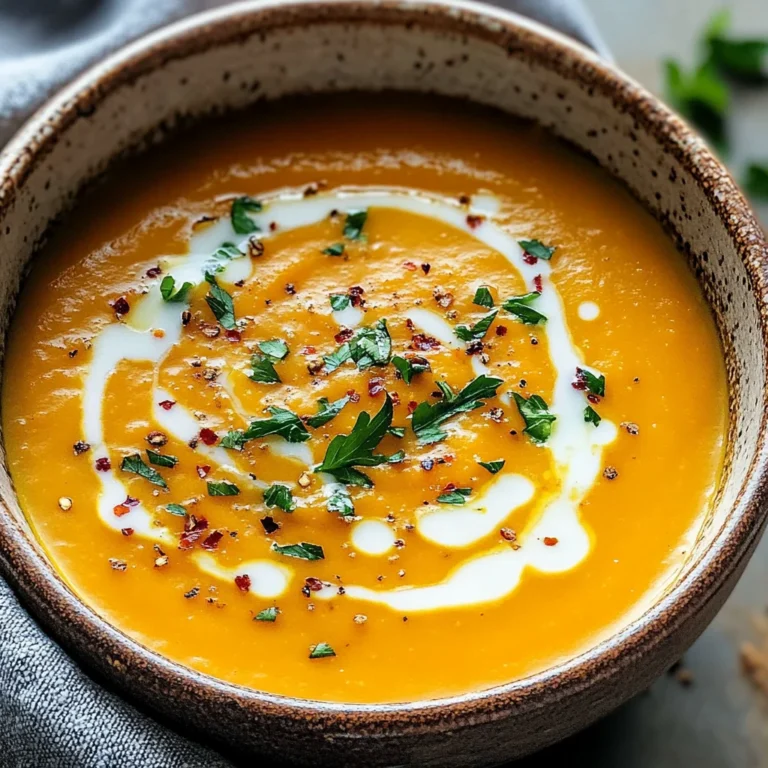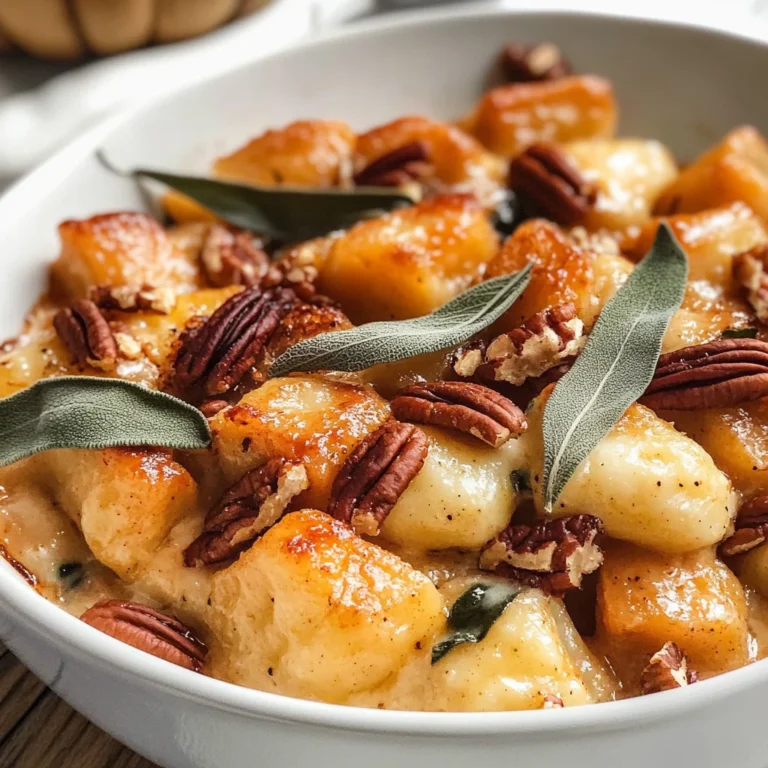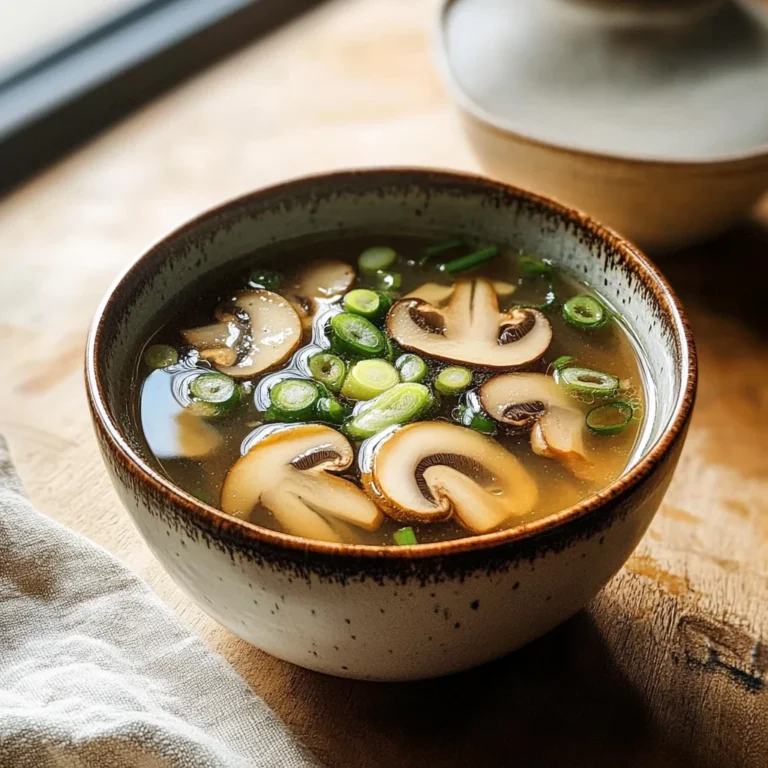Japchae
If you’re looking for a dish that’s not only delicious but also brings a sense of warmth and comfort, then Japchae is the perfect recipe for you. This traditional Korean dish features sweet potato glass noodles that are wonderfully chewy and slightly sweet, making it a delightful treat for your taste buds. What makes Japchae truly special is its versatility—whether you’re hosting a family gathering or just want something quick and satisfying on a busy weeknight, this dish fits the bill perfectly.
I love how Japchae can be easily customized to suit everyone’s preferences. You can use beef, chicken, tofu, or even shrimp! Each variation allows you to create a new experience with familiar flavors. Trust me, once you try this recipe, you’ll be reaching for it time and again.
Why You’ll Love This Recipe
- Quick to prepare: With just 30 minutes of prep time, Japchae is easy to whip up when you’re short on time.
- Family-friendly: The combination of noodles and colorful veggies makes it appealing to everyone at the table.
- Make-ahead option: You can prepare the ingredients in advance and toss everything together just before serving.
- Deliciously customizable: Swap out proteins or add your favorite vegetables to make it your own!
- Nutritious and wholesome: Packed with veggies and lean protein, this dish is as healthy as it is tasty.
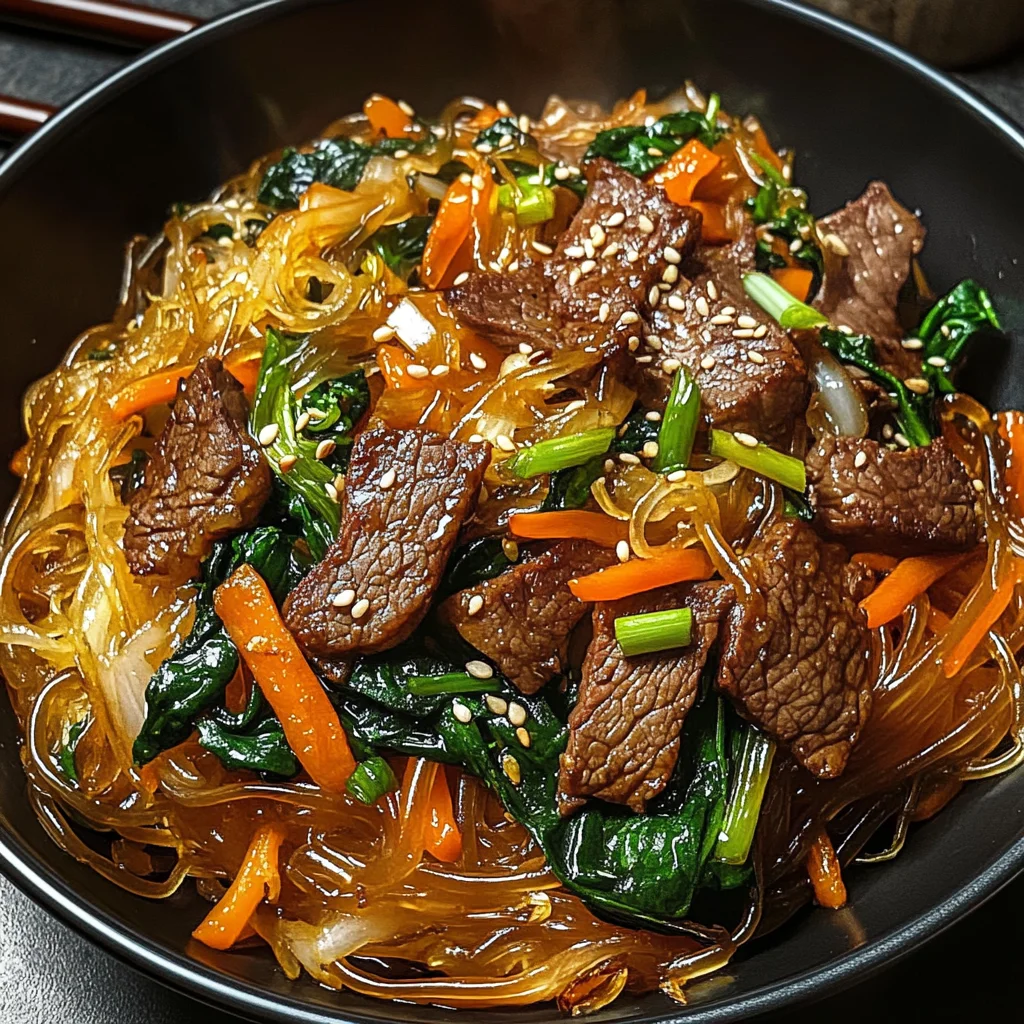
Ingredients You’ll Need
Let’s dive into the ingredients! You’ll find that these are simple, wholesome components that come together beautifully in this dish. Here’s what you’ll need to make your own Japchae:
For the Stir-Fry
- 2 lb thin-sliced beef (or substitute with chicken, tofu, or shrimp)
- 1 lb Korean sweet potato noodles (glass noodles)
- 3 medium carrots, julienned
- 1 large white onion, thinly sliced
- 1/2 bunch green onions, chopped
- 6 garlic cloves, minced
- 1/2 lb spinach leaves
For Seasoning
- 4 tbsp sesame oil (divided)
- 1 tbsp olive oil
- 6 tbsp soy sauce (or tamari for gluten-free)
- 3 tbsp brown sugar
Variations
One of the best things about Japchae is its flexibility! You can easily tweak the recipe based on what you have on hand or your taste preferences. Here are some fun ideas for variations:
- Swap the protein: Feel free to replace beef with chicken or tofu for a lighter option. Shrimp adds a delightful seafood twist!
- Add spice: If you’re feeling adventurous, mix in some gochujang for an extra kick of heat.
- Veggie overload: Toss in your favorite vegetables like bell peppers or mushrooms to ramp up the nutrition.
- Make it vegan: Simply omit any meat and add more tofu along with additional veggies for a hearty vegan version!
How to Make Japchae
Step 1: Cook the Noodles
Start by bringing water to a boil in a large pot with a drizzle of olive oil. Once boiling, add the sweet potato noodles and cook them for about 5-6 minutes until they’re tender yet chewy. Drain them well and set aside; this step creates the perfect base for our stir-fry.
Step 2: Prepare the Beef
In a skillet over high heat, cook the thin slices of beef until they are nicely browned. As they cook, season with half of the soy sauce, sesame oil, and brown sugar. This not only enhances flavor but also helps tenderize the meat. Once cooked through, set aside so we can focus on our veggies next!
Step 3: Sauté the Vegetables
Take another skillet and heat some olive oil over medium-high heat. Add the julienned carrots and sliced onion first; sauté until they soften. Then pour in the remaining soy sauce, sesame oil, and brown sugar. Adding garlic and green onions at this stage will infuse our dish with fantastic aromas—cook everything together for another minute.
Step 4: Add Spinach
Now it’s time to introduce some greens! Add spinach leaves to the skillet and stir until they wilt down nicely. This step not only adds color but also boosts nutrition in your meal.
Step 5: Combine Everything
Finally, bring all those beautiful ingredients together! In a large bowl, combine your cooked noodles with the sautéed veggies and beef (or your chosen protein). Toss everything well until combined—this ensures every bite is packed with flavor.
Serve warm with an optional garnish of extra green onions if desired. And there you have it—a gorgeous plate of homemade Japchae that’s sure to impress!
Pro Tips for Making Japchae
Making Japchae can be a delightful experience, and with these tips, you’ll ensure it’s a hit every time!
-
Choose the Right Noodles: Opt for Korean sweet potato noodles (glass noodles) for their unique chewy texture. This is what makes Japchae special, and they absorb flavors beautifully.
-
Prep Ingredients Ahead: Having all your vegetables chopped and ready to go will streamline your cooking process. You’ll be able to focus on stir-frying without any interruptions.
-
Control the Heat: Stir-fry your ingredients over high heat for that perfect char and flavor. This technique not only enhances taste but also keeps your vegetables vibrant and crisp.
-
Customize to Your Taste: Feel free to swap out proteins or add spices, like gochujang, to make the dish your own. Personalizing it can elevate your meal and cater to everyone’s preferences.
-
Serve Immediately: For the best texture and flavor, serve Japchae right after tossing everything together. It tastes amazing warm and fresh!
How to Serve Japchae
Presenting Japchae beautifully can enhance the dining experience. Here are some ideas to make it shine on your table.
Garnishes
- Sesame Seeds: A sprinkle of toasted sesame seeds adds a nutty flavor and a lovely crunch that complements the dish perfectly.
- Additional Green Onions: Chopped green onions not only add color but also a refreshing bite that balances the savory profile of Japchae.
- Chili Flakes: For those who enjoy a bit of spice, a dash of chili flakes can add an exciting kick that elevates this classic dish.
Side Dishes
- Kimchi: This fermented vegetable dish adds a tangy and spicy element that pairs wonderfully with the sweetness of Japchae.
- Korean Pickled Radish (Danmuji): The slightly sweet and sour taste of pickled radish provides a crisp contrast, enhancing the overall meal.
- Cucumber Salad (Oisobagi): A refreshing cucumber salad with vinegar dressing can cleanse the palate between bites, making it an excellent accompaniment.
- Steamed Broccoli: Lightly steamed broccoli offers additional nutrients while maintaining its vibrant green color, balancing out the flavors of the dish.
Now you’re ready to create an unforgettable Japchae experience! Enjoy this delightful dish with loved ones, and don’t forget to share your personal twists on this classic recipe!
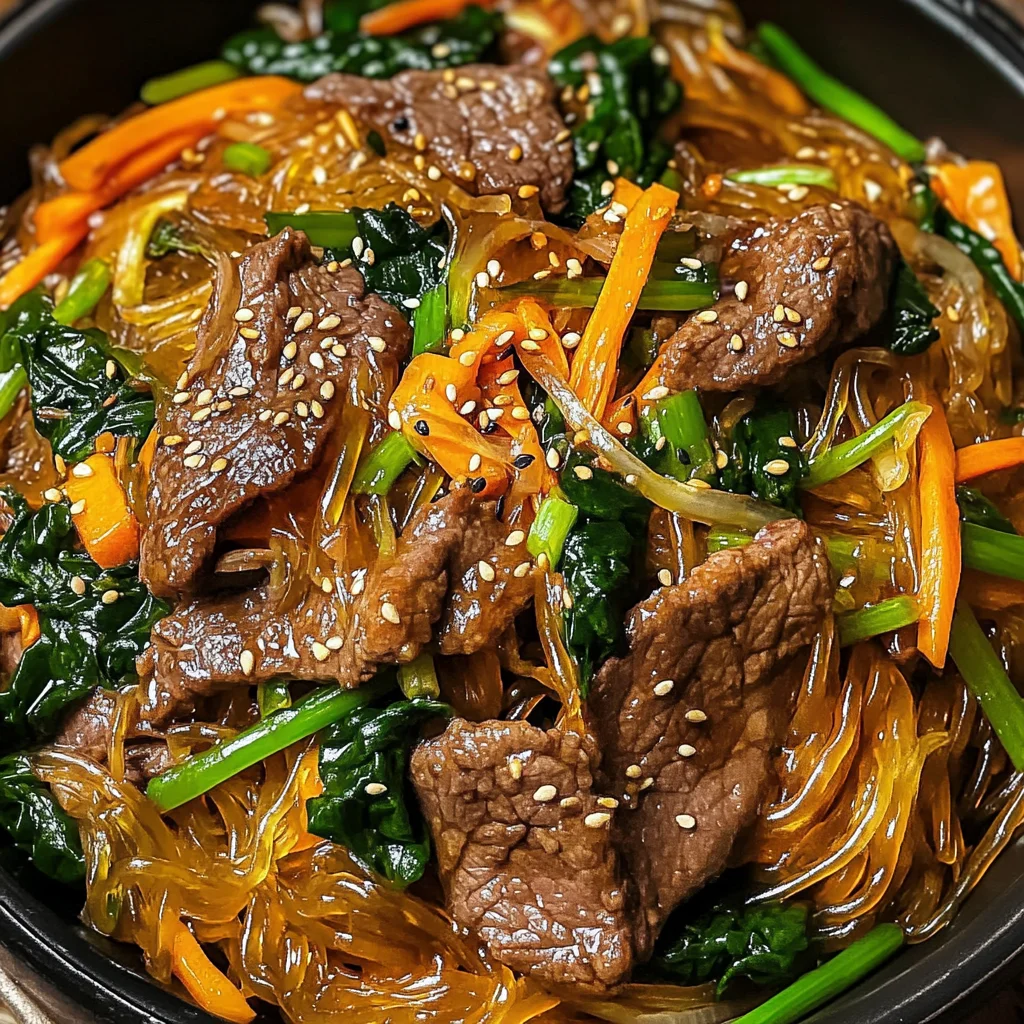
Make Ahead and Storage
Japchae is a fantastic dish for meal prep, as it keeps well in the fridge and tastes just as delicious the next day. It’s perfect for busy weekdays or gatherings where you want to impress without spending all day in the kitchen.
Storing Leftovers
- Allow the japchae to cool completely.
- Transfer it to an airtight container.
- Store in the refrigerator for up to 3 days.
Freezing
- Let the japchae cool down before freezing.
- Portion it into freezer-safe bags or containers.
- It will keep well for up to 2 months.
Reheating
- Thaw overnight in the refrigerator before reheating.
- Reheat gently in a skillet over medium heat, adding a splash of water or broth to prevent drying out.
- You can also microwave it on low power, stirring occasionally until heated through.
FAQs
Here are some common questions about making Japchae.
Can I use other proteins in my Japchae?
Absolutely! While traditional japchae often includes beef, you can easily substitute with chicken, shrimp, or tofu. Each option brings its unique flavor and texture!
What type of noodles should I use for Japchae?
The best choice for authentic japchae is Korean sweet potato glass noodles. They have a chewy texture that pairs beautifully with the stir-fried vegetables and sauce.
How do I make Japchae gluten-free?
To create a gluten-free version of japchae, simply use tamari instead of regular soy sauce. Ensure that all other ingredients are certified gluten-free as well.
Can I make Japchae vegan?
Yes! To make vegans happy, omit meat entirely and boost your dish with more colorful veggies and protein-rich tofu. This way, you still enjoy that delightful taste!
Final Thoughts
I hope this recipe brings you joy in your kitchen! Japchae is truly special—it’s versatile, vibrant, and a real crowd-pleaser at any dinner table. Enjoy making this delicious dish, and don’t hesitate to experiment with your favorite ingredients. Happy cooking!
Japchae
If you’re seeking a comforting and delicious dish that is sure to please everyone, Japchae is the answer. This traditional Korean stir-fried noodle dish features sweet potato glass noodles, which are delightfully chewy and slightly sweet. Japchae’s versatility makes it perfect for family gatherings or quick weeknight meals. Customize it with your choice of protein—beef, chicken, tofu, or shrimp—and an array of colorful vegetables for a wholesome and nutritious meal that bursts with flavor. Once you try this easy recipe, you’ll find yourself reaching for it time and again.
- Prep Time: 15 minutes
- Cook Time: 20 minutes
- Total Time: 35 minutes
- Yield: Serves 6
- Category: Main
- Method: Stir-frying
- Cuisine: Korean
Ingredients
- 2 lb thin-sliced beef (or chicken, tofu, or shrimp)
- 1 lb Korean sweet potato glass noodles
- 3 medium carrots, julienned
- 1 large white onion, thinly sliced
- 1/2 bunch green onions, chopped
- 6 garlic cloves, minced
- 1/2 lb spinach leaves
- 4 tbsp sesame oil (divided)
- 1 tbsp olive oil
- 6 tbsp soy sauce (or tamari for gluten-free)
- 3 tbsp brown sugar
Instructions
- Cook the Noodles: Boil water in a large pot with olive oil. Add sweet potato noodles and cook for 5-6 minutes until tender. Drain and set aside.
- Prepare the Protein: In a skillet over high heat, cook thin-sliced beef until browned. Season with half of the soy sauce, sesame oil, and brown sugar. Set aside.
- Sauté Vegetables: In another skillet over medium-high heat, add olive oil and sauté carrots and onion until softened. Stir in remaining soy sauce, sesame oil, brown sugar, garlic, and green onions; cook for another minute.
- Add Spinach: Incorporate spinach into the skillet and stir until wilted.
- Combine: In a large bowl, mix cooked noodles with sautéed veggies and your chosen protein; toss well to combine.
Nutrition
- Serving Size: 1 plate (300g)
- Calories: 450
- Sugar: 8g
- Sodium: 900mg
- Fat: 20g
- Saturated Fat: 3g
- Unsaturated Fat: 15g
- Trans Fat: 0g
- Carbohydrates: 50g
- Fiber: 5g
- Protein: 25g
- Cholesterol: 70mg

